A Novel Technique for High-Efficiency Characterization of Complex Cracks with Visual Artifacts
Abstract
1. Introduction
- A.
- Most crack segmentation models are developed to detect wide cracks; there are rarely any models demonstrated for complex cracks.
- B.
- Even though there is a large volume of models published, they are not optimized for complex crack segmentation.
- C.
- Most of the models require modern hardware for training, which is not always available in various laboratories.
- D.
- Training resolutions are large enough to identify context and have become essential for crack segmentation.
- A novel computational model is presented that has been specifically tailored for the high-efficiency pixel-wise segmentation of complex cracks and the characterization of these cracks in incomplete/inaccurate segmentation maps in highly imbalanced datasets.
- SHSnet is developed to achieve the segmentation of complex cracks. It consists of (A) a large receptive field that allows better learning of contextual features, (B) boundary refinement units to achieve better boundaries, (C) residual multiscale connections for ‘attention’ for long-range features and boost feature representation capability, and (D) a novel loss function (LF) to train the network efficiently on a highly imbalanced dataset with HCRF cracks. Our network design is novel and different from SOTA models (as discussed in the previous section) for crack segmentation.
- A novel post-processing unit (PPU) is developed for crack morphological parameter calculations. The PPU is based on fracture mechanics, and geometric properties are proposed. Based on this, scanning lines are used to compute crack parameter length and width and the number of complex cracks directly from inaccurate/incomplete segmentation maps.
- Novel benchmarking methodologies were proposed for (A) testing the network on a wide variety of realistic cases of different concrete surfaces and (B) automated testing for the efficiency of image processing units.
2. Proposed Method
2.1. Deep Learning Model
2.1.1. Network Component and Design
2.1.2. Loss Function (LF)
2.2. Post-Processing Unit (PPU) for Crack Morphological Parameters
3. Data Collection and Training Parameters
Ground Truth Development
4. Results
4.1. Ablation Study
4.2. Comparative Analysis of SHSnet
4.3. Performance of PPU
5. Applications
5.1. Generality across Multiple Materials
5.2. Inspection of Roads and Buildings
- (1)
- DeepCrack: This is an online dataset showcasing the cracks on asphalt and concrete road surfaces with many different surface textures. The dataset was collected by Liu et al. [22].
- (2)
- Concrete Crack Dataset (CCD): This dataset was collected in China, showcasing cracks in different sections of buildings. The data were collected by Yang et al. [19].
6. Conclusions
Author Contributions
Funding
Institutional Review Board Statement
Informed Consent Statement
Data Availability Statement
Conflicts of Interest
References
- Das, A.K.; Leung, C.K.Y. ICD: A methodology for real time onset detection of overlapped acoustic emission waves. Autom. Constr. 2020, 119, 103341. [Google Scholar] [CrossRef]
- Paul, S.C.; Pirskawetz, S.; Van Zijl, G.P.A.G.; Schmidt, W. Acoustic emission for characterising the crack propagation in strain-hardening cement-based composites (SHCC). Cem. Concr. Res. 2015, 69, 19–24. [Google Scholar] [CrossRef]
- Das, A.K.; Leung, C.K.Y. A strategy for in situ determination of self-healing state for strain hardening cementitious composites. Cem. Concr. Compos. 2020, 112, 103641. [Google Scholar] [CrossRef]
- Ranade, R.; Zhang, J.; Lynch, J.P.; Li, V.C. Influence of micro-cracking on the composite resistivity of Engineered Cementitious Composites. Cem. Concr. Res. 2014, 58, 1–12. [Google Scholar] [CrossRef]
- Das, A.K.; Lee, H.; Noda, K.; Mizuno, Y.; Leung, C.K.Y.; Nakamura, K. Potential of mechanically induced cascaded long-period grating structure for reflectometric pressure, strain, and temperature sensing. IEEE Sens. J. 2020, 20, 10539–10546. [Google Scholar] [CrossRef]
- Leung, C.; Wan, K.; Inaudi, D.; Bao, X.; Habel, W.; Zhou, Z.; Ou, J.; Ghandehari, M.; Wu, H.; Imai, M. Review: Optical fiber sensors for civil engineering applications. Mater. Struct. 2015, 48, 871–906. [Google Scholar] [CrossRef]
- Das, A.K.; Leung, C.K.Y. A fundamental method for prediction of failure of strain hardening cementitious composites without prior information. Cem. Concr. Compos. 2020, 114, 103745. [Google Scholar] [CrossRef]
- Deng, J.; Singh, A.; Zhou, Y.; Lu, Y.; Lee, V.C. Review on computer vision-based crack detection and quantification methodologies for civil structures. Constr. Build. Mater. 2022, 356, 129238. [Google Scholar] [CrossRef]
- Das, A.K.; Leung, C.K.Y.; Wan, K.T. Application of deep convolutional neural networks for automated and rapid identification and computation of crack statistics of thin cracks in strain hardening cementitious composites (SHCCs). Cem. Concr. Compos. 2021, 122, 104159. [Google Scholar] [CrossRef]
- Cha, Y.; Choi, W.; Suh, G.; Mahmoudkhani, S.; Büyüköztürk, O. Autonomous Structural Visual Inspection Using Region-Based Deep Learning for Detecting Multiple Damage Types. Comput. Aided Civ. Infrastruct. Eng. 2018, 33, 731–747. [Google Scholar] [CrossRef]
- Koch, C.; Georgieva, K.; Kasireddy, V.; Akinci, B.; Fieguth, P. A review on computer vision based defect detection and condition assessment of concrete and asphalt civil infrastructure. Adv. Eng. Inform. 2015, 29, 196–210. [Google Scholar] [CrossRef]
- Zhou, S.; Canchila, C.; Song, W. Deep learning-based crack segmentation for civil infrastructure: Data types, architectures, and benchmarked performance. Autom. Constr. 2023, 146, 104678. [Google Scholar] [CrossRef]
- Kim, C.; Hwang, S.; Sohn, H. Weld crack detection and quantification using laser thermography, mask R-CNN, and CycleGAN. Autom. Constr. 2022, 143, 104568. [Google Scholar] [CrossRef]
- Chow, J.K.; Su, Z.; Wu, J.; Tan, P.S.; Mao, X.; Wang, Y.H. Anomaly detection of defects on concrete structures with the convolutional autoencoder. Adv. Eng. Inform. 2020, 45, 101105. [Google Scholar] [CrossRef]
- Tsai, D.; Jen, P. Autoencoder-based anomaly detection for surface defect inspection. Adv. Eng. Inform. 2021, 48, 101272. [Google Scholar] [CrossRef]
- Silva, W.R.L.D.; Lucena, D.S.D. Concrete Cracks Detection Based on Deep Learning Image Classification. Proceedings 2018, 2, 489. [Google Scholar] [CrossRef]
- Słoński, M. A comparison of deep convolutional neural networks for image-based detection of concrete surface cracks. Comput. Assist. Methods Eng. Sci. 2019, 26, 105–112. [Google Scholar]
- Dung, C.V.; Anh, L.D. Autonomous concrete crack detection using deep fully convolutional neural network. Autom. Constr. 2019, 99, 52–58. [Google Scholar] [CrossRef]
- Yang, X.; Li, H.; Yu, Y.; Luo, X.; Huang, T.; Yang, X. Automatic Pixel-Level Crack Detection and Measurement Using Fully Convolutional Network. Comput. Aided Civ. Infrastruct. Eng. 2018, 33, 1090–1109. [Google Scholar] [CrossRef]
- Liu, Y.; Yeoh, J.K.W. Robust pixel-wise concrete crack segmentation and properties retrieval using image patches. Autom. Constr. 2021, 123, 103535. [Google Scholar] [CrossRef]
- Yang, F.; Zhang, L.; Yu, S.; Prokhorov, D.; Mei, X.; Ling, H. Feature Pyramid and Hierarchical Boosting Network for Pavement Crack Detection. IEEE Trans. Intell. Transp. Syst. 2019, 21, 1525–1535. [Google Scholar] [CrossRef]
- Liu, Y.; Yao, J.; Lu, X.; Xie, R.; Li, L. DeepCrack: A deep hierarchical feature learning architecture for crack segmentation. Neurocomputing 2019, 338, 139–153. [Google Scholar] [CrossRef]
- Shi, Y.; Cui, L.; Qi, Z.; Meng, F.; Chen, Z. Automatic Road Crack Detection Using Random Structured Forests. IEEE Trans. Intell. Transp. Syst. 2016, 17, 3434–3445. [Google Scholar] [CrossRef]
- Zou, Q.; Cao, Y.; Li, Q.; Mao, Q.; Wang, S. CrackTree: Automatic crack detection from pavement images. Pattern Recognit. Lett. 2012, 33, 227–238. [Google Scholar] [CrossRef]
- Choi, W.; Cha, Y. SDDNet: Real-Time Crack Segmentation. IEEE Trans. Ind. Electron. 2020, 67, 8016–8025. [Google Scholar] [CrossRef]
- Chen, L.; Papandreou, G.; Schroff, F.; Adam, H. Rethinking Atrous Convolution for Semantic Image Segmentation. arXiv 2017, arXiv:1706.05587. [Google Scholar]
- Sarmiento, J. Pavement Distress Detection and Segmentation using YOLOv4 and DeepLabv3 on Pavements in the Philippines. arXiv 2021, arXiv:2103.06467. [Google Scholar]
- Li, Y.; Bao, T.; Huang, X.; Chen, H.; Xu, B.; Shu, X.; Zhou, Y.; Cao, Q.; Tu, J.; Wang, R.; et al. Underwater crack pixel-wise identification and quantification for dams via lightweight semantic segmentation and transfer learning. Autom. Constr. 2022, 144, 104600. [Google Scholar] [CrossRef]
- Xu, R.; Hao, R.; Huang, B. Efficient surface defect detection using self-supervised learning strategy and segmentation network. Adv. Eng. Inform. 2022, 52, 101566. [Google Scholar] [CrossRef]
- Howard, A.G.; Zhu, M.; Chen, B.; Kalenichenko, D.; Wang, W.; Weyand, T.; Andreetto, M.; Adam, H. MobileNets: Efficient Convolutional Neural Networks for Mobile Vision Applications. arXiv 2017, arXiv:1704.04861. [Google Scholar]
- Song, Q.; Wu, Y.; Xin, X.; Yang, L.; Yang, M.; Chen, H.; Liu, C.; Hu, M.; Chai, X.; Li, J. Real-Time Tunnel Crack Analysis System via Deep Learning. IEEE Access 2019, 7, 64186–64197. [Google Scholar] [CrossRef]
- Ronneberger, O.; Fischer, P.; Brox, T. U-Net: Convolutional Networks for Biomedical Image Segmentation. In Proceedings of the 18th International Conference, Munich, Germany, 5–9 October 2015. [Google Scholar]
- Oktay, O.; Schlemper, J.; Folgoc, L.; Lee, M.; Heinrich, M.; Misawa, K.; Mori, K.; McDonagh, S.; Hammerla, N.; Kainz, B.; et al. Attention U-Net: Learning Where to Look for the Pancreas. arXiv 2018, arXiv:1804.03999. [Google Scholar]
- Ran, R.; Xu, X.; Qiu, S.; Cui, X.; Wu, F. Crack-SegNet: Surface Crack Detection in Complex Background Using Encoder-Decoder Architecture. In Proceedings of the 2021 4th International Conference on Sensors, Signal and Image Processing, Nanjing, China, 15–17 October 2021. [Google Scholar]
- Yao, Z.; Xu, J.; Hou, S.; Mooi, C.C. CrackNex: A Few-shot Low-light Crack Segmentation Model Based on Retinex Theory for UAV Inspections. arXiv 2024, arXiv:2403.03063. [Google Scholar]
- Zhang, L.; Shen, J.; Zhu, B. A research on an improved Unet-based concrete crack detection algorithm. Struct. Health Monit. 2021, 20, 1864–1879. [Google Scholar] [CrossRef]
- Zhou, Z.; Siddiquee, M.M.R.; Tajbakhsh, N.; Liang, J. UNet++: A Nested U-Net Architecture for Medical Image Segmentation. In Deep Learning in Medical Image Analysis and Multimodal Learning for Clinical Decision Support; Springer: Berlin/Heidelberg, Germany, 2018. [Google Scholar]
- Ali, R.; Cha, Y. Attention-based generative adversarial network with internal damage segmentation using thermography. Autom. Constr. 2022, 141, 104412. [Google Scholar] [CrossRef]
- Zhang, Y.; Liu, C. Network for robust and high-accuracy pavement crack segmentation. Autom. Constr. 2024, 162, 105373. [Google Scholar] [CrossRef]
- Hao, Z.; Lu, C.; Li, Z. Highly accurate and automatic semantic segmentation of multiple cracks in engineered cementitious composites (ECC) under dual pre-modification deep-learning strategy. Cem. Concr. Res. 2023, 165, 107066. [Google Scholar] [CrossRef]
- Guo, P.; Meng, W.; Bao, Y. Automatic identification and quantification of dense microcracks in high-performance fiber-reinforced cementitious composites through deep learning-based computer vision. Cem. Concr. Res. 2021, 148, 106532. [Google Scholar] [CrossRef]
- Lepech, M.; Li, V.C. Design and field demonstration of ECC link slabs for jointless bridge decks. In Proceedings of the Third International Conference on Construction Materials: Performance, Innovations and Structural Implications, Vancouver, BC, Canada, 22–24 August 2005. [Google Scholar]
- Li, V.C.; Fischer, G.; Kim, Y.; Lepech, M.D.; Qian, S.; Weimann, M.; Wang, S. Durable Link Slabs for Jointless Bridge Decks Based on Strain-Hardening Cementitious Composites; The National Academies of Sciences, Engineering, and Medicine: Washington, DC, USA, 2003. [Google Scholar]
- Rokugo, K. Applications of SHCC in Japan—Tools and Tips for Promoting its Use. In Strain-Hardening Cement-Based Composites; Springer: Dordrecht, The Netherlands, 2017. [Google Scholar]
- Rokugo, K.; Kunieda, M.; Lim, S.C. Patching repair with ECC on cracked concrete surface. Proc. ConMat 2005, 5, 22–24. [Google Scholar]
- Tan, M.; Le, Q.V. EfficientNet: Rethinking Model Scaling for Convolutional Neural Networks. In Proceedings of the 36th International Conference on Machine Learning, Long Beach, CA, USA, 9–15 June 2019. [Google Scholar]
- Peng, C.; Zhang, X.; Yu, G.; Luo, G.; Sun, J. Large Kernel Matters—Improve Semantic Segmentation by Global Convolutional Network. In Proceedings of the 2017 IEEE Conference on Computer Vision and Pattern Recognition (CVPR), Honolulu, HI, USA, 21–26 July 2017. [Google Scholar]
- Dice, L.R. Measures of the Amount of Ecologic Association Between Species. Ecology 1945, 26, 297–302. [Google Scholar] [CrossRef]
- Lin, T.; Goyal, P.; Girshick, R.; He, K.; Dollar, P. Focal Loss for Dense Object Detection. IEEE Trans. Pattern Anal. Mach. Intell. IEEE Trans Pattern Anal Mach Intell 2020, 42, 2980–2988. [Google Scholar] [CrossRef]
- Kang, D.; Benipal, S.S.; Gopal, D.L.; Cha, Y. Hybrid pixel-level concrete crack segmentation and quantification across complex backgrounds using deep learning. Autom. Constr. 2020, 118, 103291. [Google Scholar] [CrossRef]
- Shoemake, K. Graphics Gems IV; Academic Press: Cambridge, MA, USA, 1994. [Google Scholar]
- Li, V.C. Engineered Cementitious Composites (ECC): Bendable Concrete for Sustainable and Resilient Infrastructure, 1st ed.; Springer: Berlin/Heidelberg, Germany, 2019. [Google Scholar]
- Szegedy, C.; Liu, W.; Jia, Y.; Sermanet, P.; Reed, S.; Anguelov, D.; Erhan, D.; Vanhoucke, V.; Rabinovich, A. Going deeper with convolutions. In Proceedings of the IEEE Conference on Computer Vision and Pattern Recognition, Boston, MA, USA, 7–12 June 2015; pp. 1–9. [Google Scholar]
- He, K.; Zhang, X.; Ren, S.; Sun, J. Deep Residual Learning for Image Recognition. In Proceedings of the IEEE Computer Society Conference on Computer Vision and Pattern Recognition (CVPR), Las Vegas, NV, USA, 27–30 June 2016. [Google Scholar]
- Das, A.K.; Qiu, J.; Leung, C.K.Y.; Yu, J. A novel strategy to assess healing induced recovery of mechanical properties of strain hardening cementitious composites through autogenous healing. Cem. Concr. Compos. 2023, 142, 105177. [Google Scholar] [CrossRef]
- Lepech, M.D.; Li, V.C. Water permeability of engineered cementitious composites. Cem. Concr. Compos. 2009, 31, 744–753. [Google Scholar] [CrossRef]
- Van Zijl, G.P.; Slowik, V. A Framework for Durability Design with Strain-Hardening Cement-Based Composites (SHCC): State-of-the-Art Report of the RILEM Technical Committee 240-FDS; Springer: Berlin/Heidelberg, Germany, 2017. [Google Scholar]
- Das, A.K.; Leung, C. Power spectral entropy of acoustic emission signal as a new damage indicator to identify the operating regime of strain hardening cementitious composites. Cem. Concr. Compos. 2019, 104, 103409. [Google Scholar] [CrossRef]
- Gryguć, A.; Behravesh, S.B.; Jahed, H.; Wells, M.; Williams, B.; Su, X. Multiaxial Fatigue and Cracking Orientation of Forged AZ80 Magnesium Alloy. Procedia Struct. Integerity 2020, 25, 486–495. [Google Scholar] [CrossRef]
- Macek, W.; Branco, R.; de Jesus, J.; Costa, J.D.; Zhu, S.-P.; Nejad, R.M.; Gryguć, A. Strain energy density and entire fracture surface parameters relationship for LCF life prediction of additively manufactured 18Ni300 steel. Int. J. Damage Mech. 2024, 10567895241245879. [Google Scholar] [CrossRef]
- Gryguć, A.; Karparvarfard, S.M.H.; Roostaei, A.; Toscano, D.; Shaha, S.; Behravesh, B.; Jahed, H. On the Load Multiaxiality Effect on the Cyclic Behaviour of Magnesium Alloys. In Magnesium Technology 2020; Springer International Publishing: Berlin/Heidelberg, Germany, 2020. [Google Scholar]
- Shelhamer, E.; Long, J.; Darrell, T. Fully Convolutional Networks for Semantic Segmentation. IEEE Trans. Pattern Anal. Mach. Intell. 2017, 39, 3431–3440. [Google Scholar] [CrossRef]



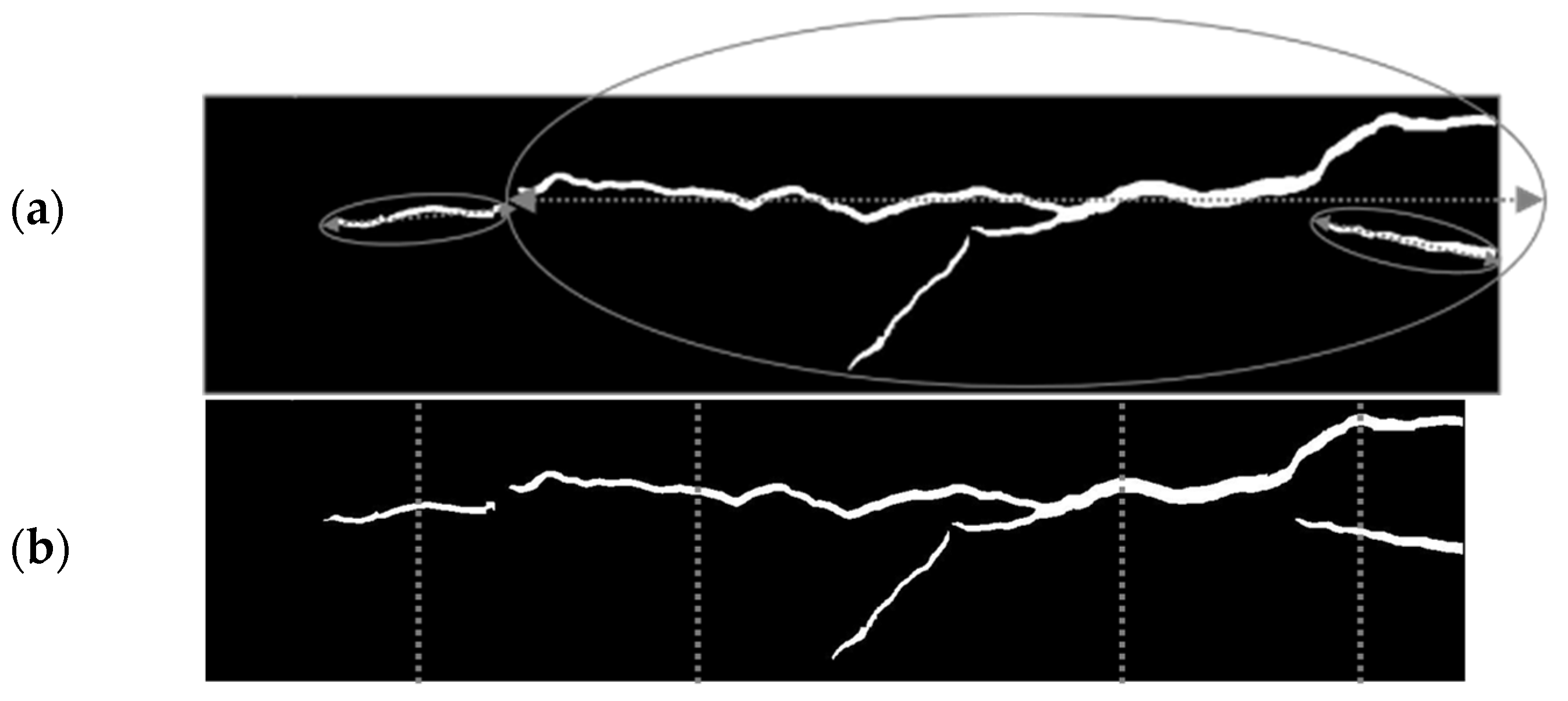
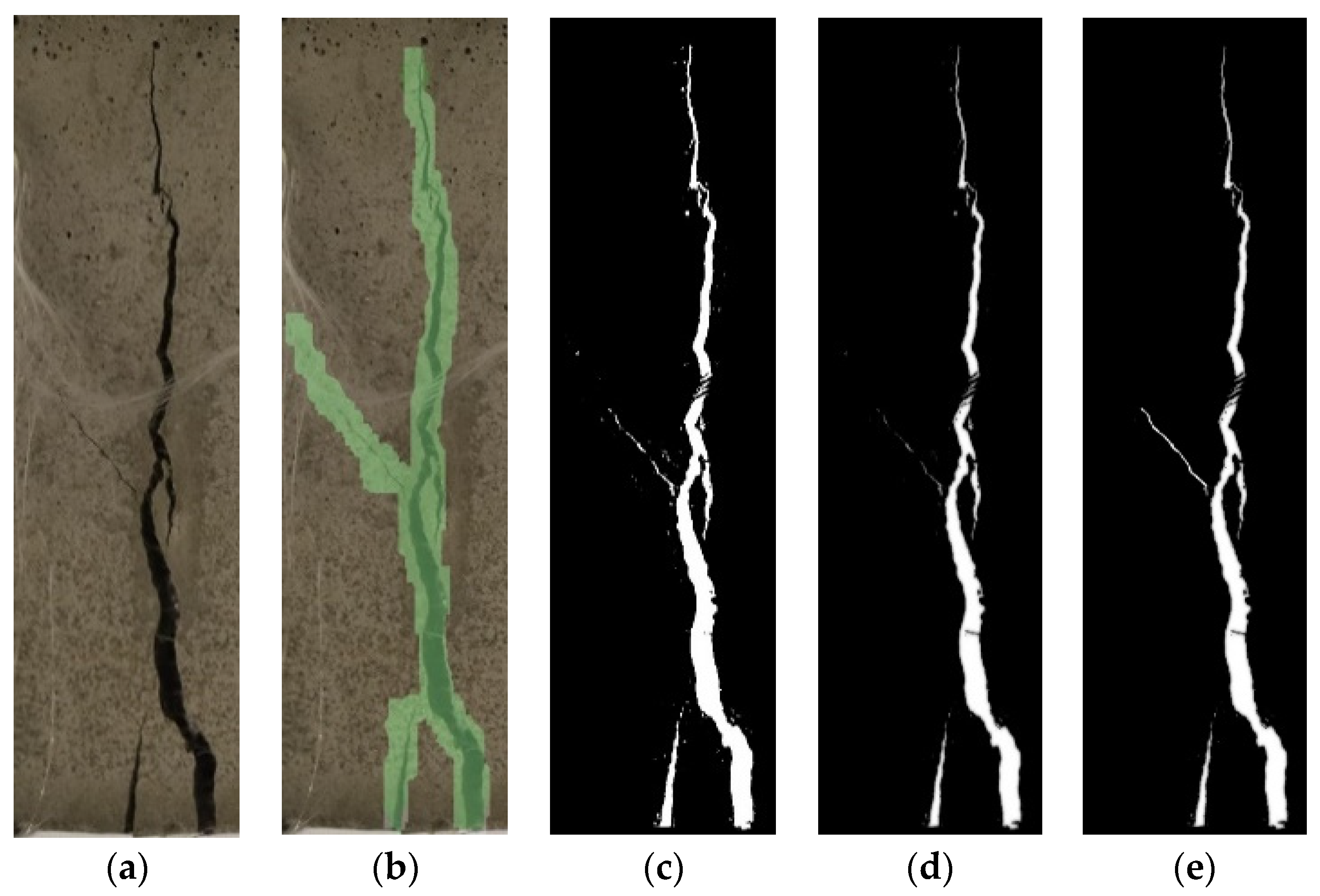


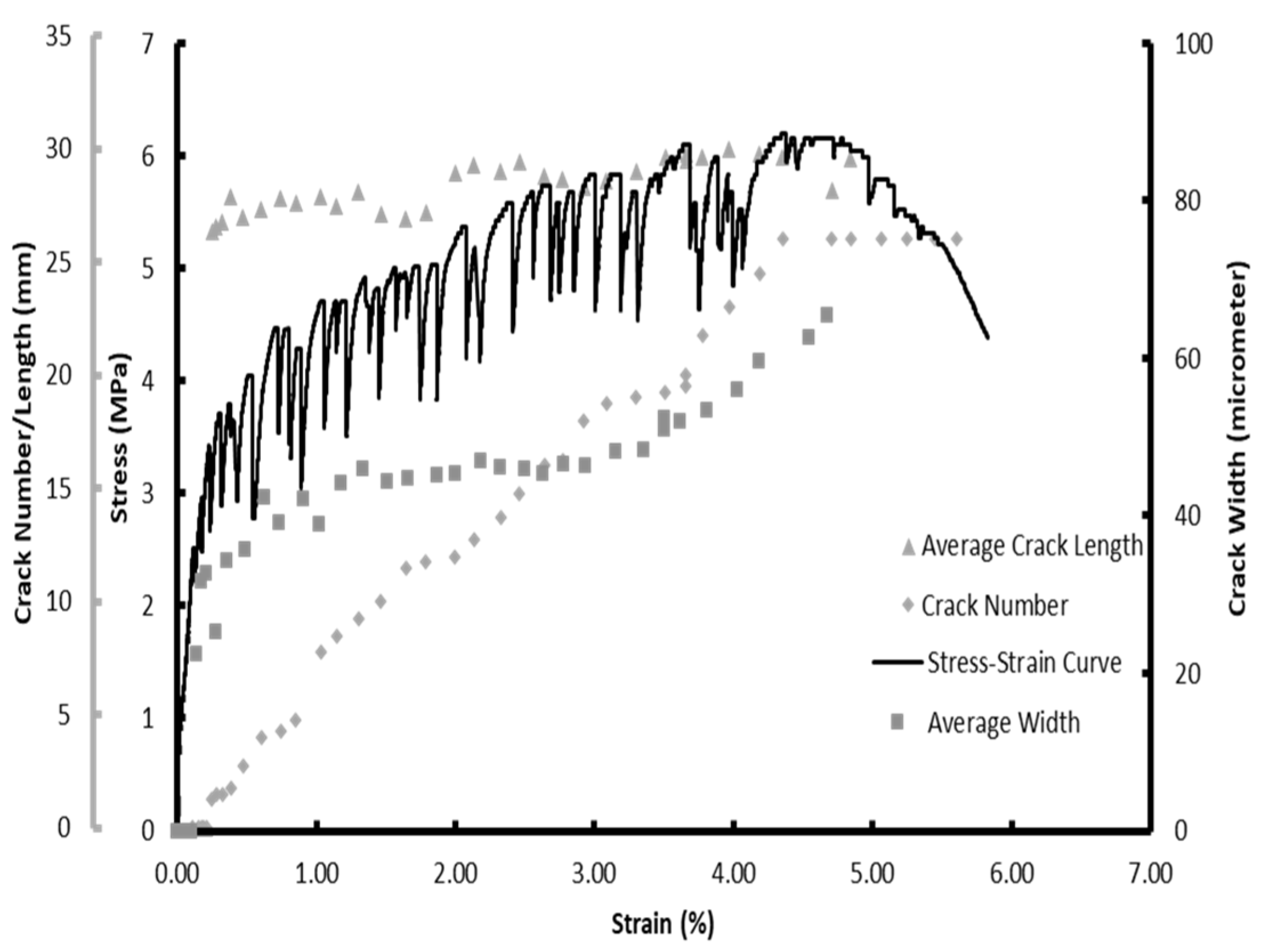
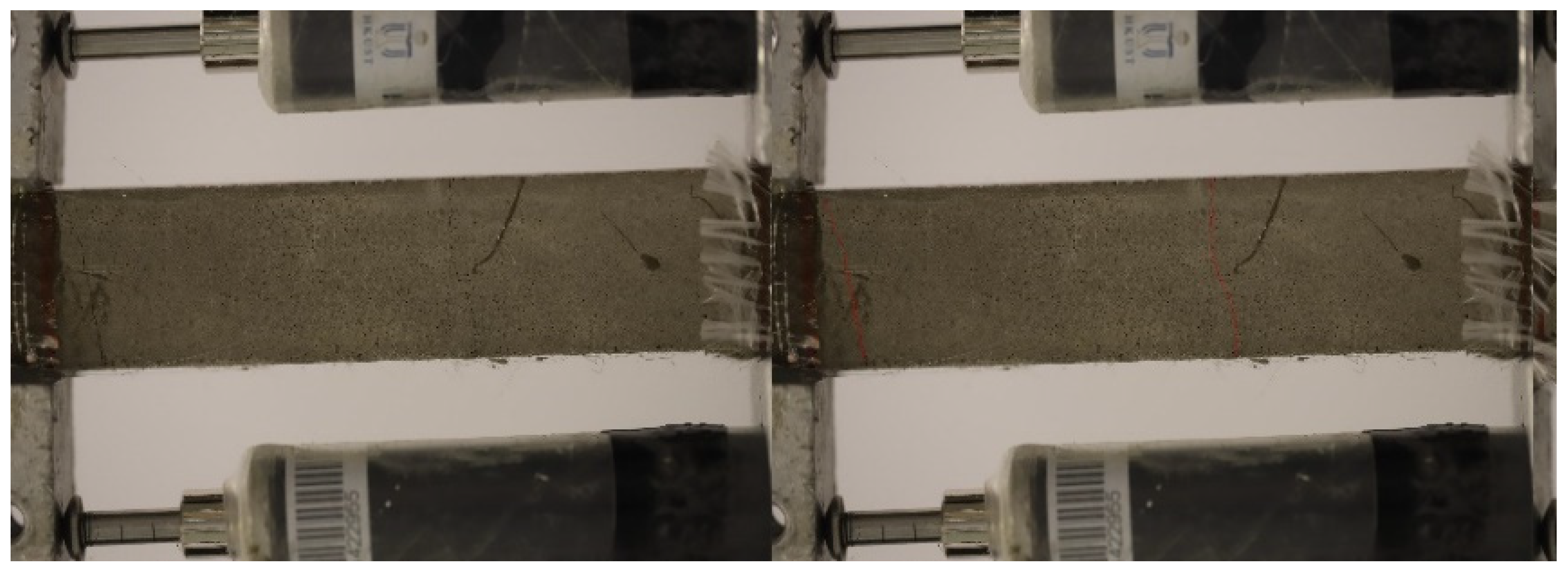
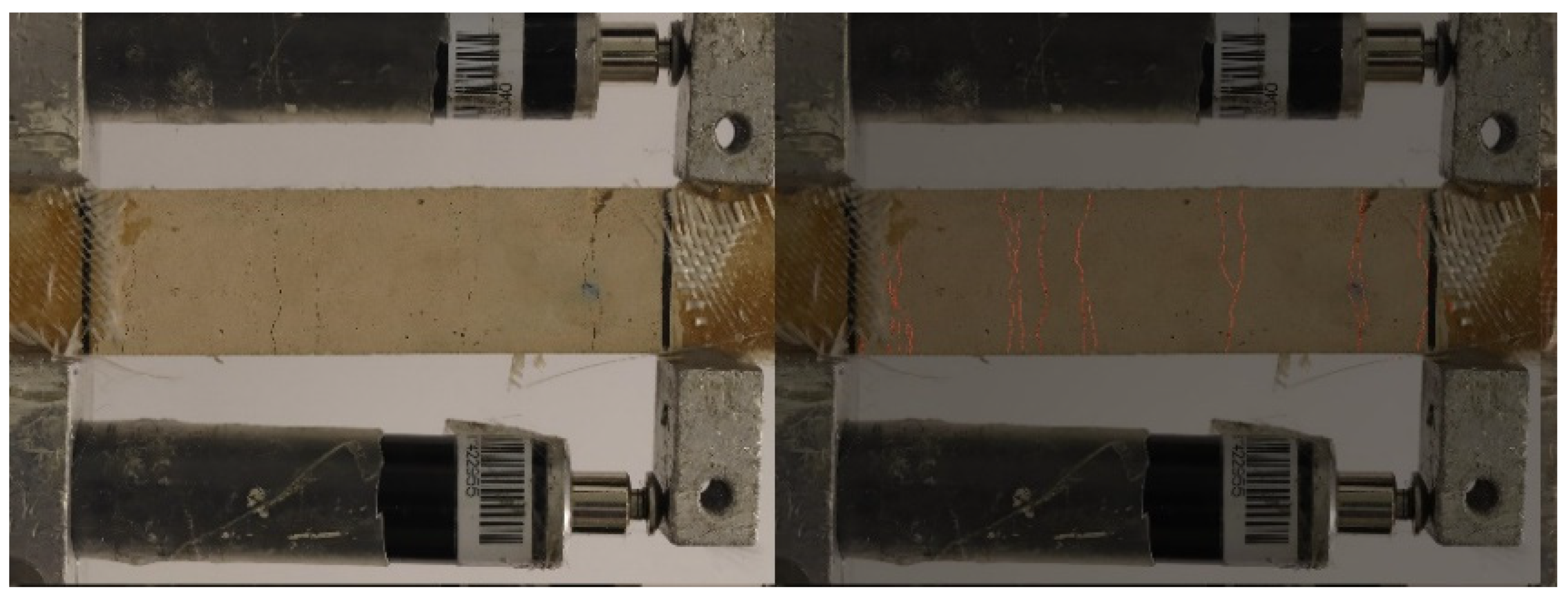
| Model Name | Based on | Publication Year | Hardware | ECC Cracks | Training Resolution |
|---|---|---|---|---|---|
| MixCrackNet | Multiscale Attention | 2024 | 3090 | No | 512 × 512 |
| Dynamic Semantic Segmentation | Encoder–Crossor–Decoder | 2023 | 3060 | No | 256 × 256 |
| Typical-RC-AI | VGG-16 | 2018 | 1080 Ti | No | 224 × 224 |
| DcsNet | Resnet18+ Pyramid Pooling | 2023 | Titan XP | No | 640 × 544 |
| DeepCrack | 2019 | Titan-X | No | 544 × 384 | |
| CrackGauGAN | Generative AI | 2024 | 3090 Ti | No | 256 × 256 |
| Ji’s Model | DeeplabV3+ | 2020 | Quadro P4000 | No | 512 × 512 |
| SDDnet | Encoder+Decoder+ASPP | 2019 | 4xTitan X | No | 1024 × 512 |
| CrackNex | Resenet 101+ Fusion Module | 2024 | Titan RTX | No | 400 × 400 |
| STRnet | 2022 | Titan XP | No | 1024 × 512 | |
| CSegNet | DeeplabV3+; Transformer | 2024 | 3080 | No | 560 × 380 |
| IDSnet | 2022 | Titan XP | No | 640 × 480 | |
| FPHBN | 2019 | Titan X | No | 480 × 320 | |
| Unet++ | U-Net | 2019 | 2080 Ti | No | 512 × 512 |
| Attention-Unet | U-Net | 2019 | No | 48 × 48 | |
| AFFnet | ResNet | 2019 | No | 224 × 224 | |
| CrackSegnet | SegNet | 2021 | 1080 Ti | No | 512 × 512 |
| Segnet | Segnet | 1060 | No | 256 × 256 | |
| CrackUnet | U-Net | 2021 | 1080 Ti | No | 256 × 256 |
| FCN | FCN | 2019 | 1070 | No | 227 × 227 |
| ECC1 | U-Net | 2022 | 3090 | Yes | 512 × 512 |
| ECC2 | U-net | 2023 | 3090 Ti | Yes | 480 × 352 |
| Components | Performance | ||||||
|---|---|---|---|---|---|---|---|
| Encoder | GCN + BN | Decoder | Loss Function | Accuracy | IOU | BF Score | Parameter × SHSnet |
| ENC | No | Bilinear Interpolation | NA | 0.53 | ** | ** | 0.9× |
| ENC | No | Nearest Neighbor Interpolation | NA | 0.52 | ** | ** | 0.9× |
| ResNet-18 | Yes | Yes | LF | 0.78 | 0.72 | 0.75 | 2.3× |
| ResNet-50 | Yes | Yes | LF | 0.84 | 0.79 | 0.81 | 5× |
| MobileNet | Yes | Yes | LF | 0.74 | 0.71 | 0.73 | 0.7× |
| VGG-16 | Yes | Yes | LF | 0.72 | 0.69 | 0.70 | >10× |
| ENC | No | Yes | LF | 0.81 | 0.74 | 0.74 | ~0.95× |
| ENC | Yes | Yes | Cross-Entropy | 0.66 | 0.51 | 0.54 | 1× |
| ENC | Yes | Yes | LF | 0.88 | 0.81 | 0.84 | 1× |
| Deep Learning Model | Performance | |||||
|---|---|---|---|---|---|---|
| Accuracy | Precision | Recall | IOU | BF Score | Param. | |
| Typical-RC-AI | 0.66 | 0.74 | 0.46 | 0.56 | 0.56 | 34M |
| CrackUnet7 | 0.71 | 0.51 | 0.64 | 0.59 | 0.63 | |
| CrackUnet11 | 0.78 | 0.58 | 0.71 | 0.71 | 0.72 | |
| CrackUnet15 | 0.82 | 0.70 | 0.84 | 0.77 | 0.78 | 30M |
| DeepLabv3+ | 0.78 | 0.79 | 0.72 | 0.74 | 0.76 | 16M |
| Song’s Model | 0.74 | 0.75 | 0.67 | 0.71 | 0.73 | 9M |
| FCN | 0.62 | 0.53 | 0.56 | 0.53 | 0.51 | 132M |
| CrackSegnet | 0.76 | 0.75 | 0.76 | 0.64 | 0.67 | 15M |
| SHSnet | 0.88 | 0.85 | 0.83 | 0.81 | 0.84 | 4M |
| Computing With | Crack Number | Crack Width | Crack Length |
|---|---|---|---|
| Proposed Model | 0.3–5 min/image * | ||
| Manual | ~6 min/image | ~200 min/image * | ~100 min/image |
| Experimental Condition | SHSnet | Conven. | ||
|---|---|---|---|---|
| Surface Preparation? | Surface Color | Crack Density | Accuracy | Accuracy |
| Yes | NA | NA | 0.924 | 0.609 |
| No | Light | Medium | 0.889 | 0.544 |
| No | Light | High | 0.891 | 0.521 |
| No | Dark | High | 0.874 | 0.504 |
| No | Dark | Medium | 0.869 | 0.513 |
| Images From Internet/Literature | 0.853 | 0.439 | ||
| Method | Parameters | CCD | DeepCrack | ||||
|---|---|---|---|---|---|---|---|
| Pre | Rec | F1 | Pre | Rec | F1 | ||
| Typical-RC-AI | 34M | 0.81 | 0.78 | 0.79 | 0.73 | 0.76 | 0.75 |
| DeeplabV3+ | 16M | 0.79 | 0.75 | 0.77 | 0.74 | 0.68 | 0.72 |
| FCN | 132M | 0.71 | 0.71 | 0.71 | 0.67 | 0.67 | 0.67 |
| CrackUnet | 32M | 0.91 | 0.86 | 0.88 | 0.87 | 0.83 | 0.86 |
| CrackSegnet | 15M | 0.85 | 0.87 | 0.86 | 0.82 | 0.79 | 0.82 |
| Ours (SHSnet) | 4M | 0.95 | 0.96 | 0.95 | 0.96 | 0.93 | 0.94 |
Disclaimer/Publisher’s Note: The statements, opinions and data contained in all publications are solely those of the individual author(s) and contributor(s) and not of MDPI and/or the editor(s). MDPI and/or the editor(s) disclaim responsibility for any injury to people or property resulting from any ideas, methods, instructions or products referred to in the content. |
© 2024 by the authors. Licensee MDPI, Basel, Switzerland. This article is an open access article distributed under the terms and conditions of the Creative Commons Attribution (CC BY) license (https://creativecommons.org/licenses/by/4.0/).
Share and Cite
Das, A.K.; Leung, C.K.Y. A Novel Technique for High-Efficiency Characterization of Complex Cracks with Visual Artifacts. Appl. Sci. 2024, 14, 7194. https://doi.org/10.3390/app14167194
Das AK, Leung CKY. A Novel Technique for High-Efficiency Characterization of Complex Cracks with Visual Artifacts. Applied Sciences. 2024; 14(16):7194. https://doi.org/10.3390/app14167194
Chicago/Turabian StyleDas, Avik Kumar, and Christopher Kin Ying Leung. 2024. "A Novel Technique for High-Efficiency Characterization of Complex Cracks with Visual Artifacts" Applied Sciences 14, no. 16: 7194. https://doi.org/10.3390/app14167194
APA StyleDas, A. K., & Leung, C. K. Y. (2024). A Novel Technique for High-Efficiency Characterization of Complex Cracks with Visual Artifacts. Applied Sciences, 14(16), 7194. https://doi.org/10.3390/app14167194






